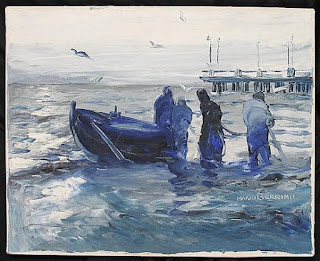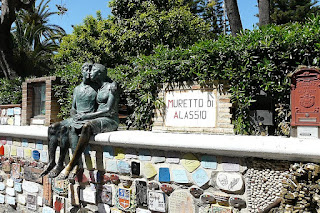Olympic gold medallist set up prestige cycle brand
 |
| Giuseppe Olmo showed great talent from an early age |
Olmo missed out on an individual medal in Los Angeles, finishing fourth behind compatriot Attilio Pavesi in the road race, but won gold as part of the winning Italy trio in the team event, alongside Pavesi and Guglielmo Segato.
He turned professional after the Olympics and, though his career was truncated somewhat by the cessation of the sport during World War Two, enjoyed some success.
Racing for the Fréjus team, he won the Milan-Turin race at the age of just 21 in 1932. After moving to the colours of Bianchi, Olmo won the prestigious Milan-San Remo race three years later and in 1938, the Giro dell’Emilia in 1936 and the Giro di Campania in 1938.
Olmo was somewhat unlucky in the Giro d’Italia. He finished third behind Vasco Bergamaschi in 1935 after winning four stages and wearing the leader’s pink jersey for seven days, and runner-up the following year despite winning 10 stages - the same number Learco Guerra took as champion two years previously - as the overall classification went to Gino Bartali.
Olmo Biciclette was launched in 1939 and has supplied bikes for many professionals, as well producing them for the commercial market.
 |
| A youthful Olmo pictured with his mentor, the Ligurian cyclist Giusppe Olivieri |
Under Olivieri’s guidance, his talent came to the surface. He preceded his excellent performance at the 1932 Olympics by winning the Italian road championship in 1931 and finishing runner-up in the amateurs’ road race at the World championships in Copenhagen the same year.
As well as his race success, Olmo entered the record books in 1935 for the longest distance covered in one hour on the track.
Riding an 8.5kg Bianchi bike at an almost deserted Vigorelli Velodrome on 31 October in Milan, having decided on his record attempt only 24 hours before it took place, Olmo became the first in history to break the 45km mark, recording a distance of 45.090km.
He held the record for less than a year, however. On 16 October in 1936, the Frenchman Maurice Richard, whose record Olmo took, reclaimed it, bettering his mark with 45.32km.
Olmo was planning for his life after retirement while he was still competing, opening the first Olmo Biciclette factory in partnership with his brothers, Franco, Giovanni and Michele, in Celle Ligure, in 1939.
 |
| The Olmo brand became synonymous with quality |
Pierino Gavazzi, whose career wins included Milan-Sanremo and Paris-Brussels, the Vuelta a España winner Marino Lejarreta and three-times World champion Óscar Freire were among the professionals who enjoyed great success riding Olmo bikes.
Olmo, who was married with three daughters, died in Milan in 1992 but the company survived him, moving into the production of polyurethane flexible foams from a factory at Comun Nuovo, a municipality about 9km (six miles) south of Bergamo in Lombardy.
Bicycles carrying the Olmo brand, including the latest incarnation of the flagship Gepin model, are now produced and distributed by Montana Srl from their factory at Magliano Alpi in Piemonte, about 80km (50 miles) northwest of Celle Ligure.
 |
| Celle Ligure's sandy beach has helped make it a popular destination for visitors to Liguria |
A lesser known gem of the Italian Riviera, Celle Ligure has grown around a picturesque former fishing village with a small sandy beach lined with pastel-coloured houses, behind which is a small, historic old town of narrow lanes. Founded in the 11th century near the Saint Beningo monastery, Celle Ligure came under the control of Genoa in the 13th century and enjoyed prosperity in the 17th and 18th centuries through trade with France, Spain and America. That ended, however, with the French occupation of Genoa in 1805. The arrival of a railway line in 1868 was the beginning of Celle Ligure’s evolution as a tourist destination, which underpins its economy today. As well as the attractions of the beach, Celle Ligure has a 17th century church, the Oratorio of San Michele, which features a polyptych by Perino del Vaga, a late Renaissance painter from Florence. As well as Giuseppe Olmo, the village is the birthplace of Francesco della Rovere, who as Pope Sixtus IV commissioned Michelangelo to paint the ceiling of the Sistine Chapel at the Vatican.
 |
| Sanremo is known for its fine Stile Liberty buildings, such as its striking 1905 Casino |
The Milan-Sanremo cycle race, won twice by Giuseppe Olmo, is one of the sport’s oldest and most prestigious single-day contests, one of the five so-called Monuments in the European cycling calendar, the toughest and most demanding of the one-day events. First contested in 1907 and covering a distance of 286km (177 miles), the race followed a course said to have begun at the Conca Fallata Inn, next to a navigation basin on the Naviglio Pavese canal in Milan and ended on Corso Cavallotti on the outskirts of Sanremo, the seaside town on the coast of Liguria famed for its temperate Mediterranean climate. Sanremo - 110km (68 miles) further west along the Ligurian coast from Celle Ligure, expanded rapidly in the mid-18th century, when the phenomenon of tourism began to take hold. It is characterised by many fine examples of Stile Liberty, the Italian variant of the Art Nouveau design and architectural style.
Also on this day:
1533: The birth of Alfonso II d’Este, Duke of Ferrara
1710: The death of Baroque composer Bernardo Pasquini
1902: The birth of Mafia boss Joe Adonis
1947: The birth of football coach Nevio Scala
1949: The birth of entrepreneur Rocco Commisso
1954: The birth of politician Paolo Gentiloni


.jpg)

.PNG)










